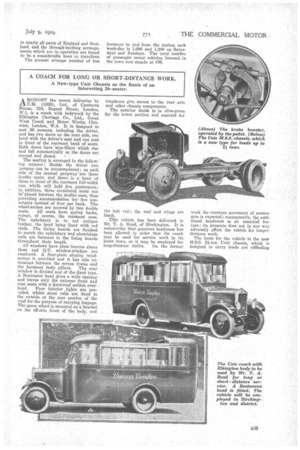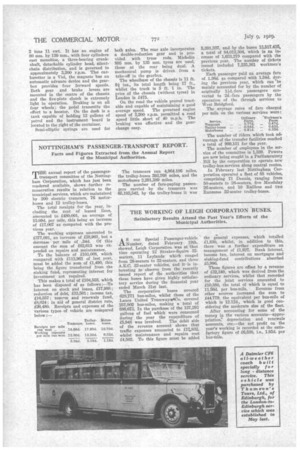A COACH FOR LONG OR SHORT-DISTANCE WORK.
Page 117

Page 118

If you've noticed an error in this article please click here to report it so we can fix it.
A New-type Unie Chassis as the Basis of an Interesting 26-seater.
AMONGST the recent deliveries by U.M. (1928), Ltd., of Canberra House, 319, Regent Street, London, W.1, is a coach with bodywork by the Elkington Carriage Co., Ltd., Great West Coach and Motor Works, Chiswick, London, W.4. It is designed to seat 26 persons, including the driver, and has two doors on the near side, one level with the driver's seat and one just in front of the rearmost bank of seats. Both doors have -step-fillers which rise and fall automatically as the doors are opened and closed.
The seating is arranged in the following manner : Beside the driver two persons can be accommodated ; on each side of the central gangway ' are three 'double seats, and there is a bank of three in front of the rearmost full-width 'one, whin will hold five passengers; in addition, three occasional seats can be placed between the double ones, thus providing accommodation for five passengers instead of four per bank. The Wheel-arches are covered by two double seats. All seats have spring backs, except, of course, the reartnost ones. The upholstery is in red antique leather, the head being lined with red cloth. The lining boards are finished to match the upholstery and aluminium rails are fastened to the lining boards throughout their length.
AU windows have glass louvres above them and Q.T. window-winders are employed. A four-piece sloping windscreen is provided and it has side extensions between the screen frame and the foremost body pillars. The rear window is divided and of the fixed type. A Beatoiason head gives a wide opening and leaves only the extreme front and rear seats with a fixed-roof section over
head. Four interior lights are provided, whilst stout rails are fixed to the outside of the rear portion of the roof for the purpose of carrying luggage. The spare wheel is mounted on a bracket on the off-side front of the body, and
trapdoors give access to the rear axle and other chassis components.
The exttrior finish is in olive-green for the lower portion and emerald for
the belt rail ; the roof and wings are black.
This vehicle has been delivered to Mr. T. A. Read, of Birehington. It is noteworthy that generous headroom has been allowed in order that the coach may be used for service work in its home town, or it may be employed for
long-distance duties. On the former work the constant movement of passengers is expected; consequently, the additional headroom is an essential feature; its presence does not in any way adversely affect the vehicle for longerdistance work.
The basis for the vehicle is the new M.9.0. 21-ton TJnic chassis, which is designed to carry loads not effeeding
2 tons 11 cwt. It has an engine of 80 mm. by 130 mm., with four cylinders east monobloc, a three-bearing crankshaft, detachable cylinder head, silentchain distribution, and is governed to approximately 3,200 r.p.m. Thei carburetter is a Vie!, the magneto has an automatic advance device and the gearbox provides four forward speeds. Both gear and brake levers are mounted in the centre of the chassis and the five-plate clutch is extremely light in operation. Braking is on all four wheels ; the pedal transmits the effort to a booster. On the dash is a tank capable of holding 12 gallons of petrol and the instrument board is located to the right of the container.
Semi-elliptic springs are used for both axles. The rear axle incorporates a double-reduction gear and is provided with truss rods. Michelin 895 mm. by 135 mm. tyres are used, those at the rear being dual. A mechanical pump is driven from a take-off in the gearbox.
The wheelbase of the chassis is 11 ft. 94 ins., its total length being 17 ft., whilst the track is 5 ft. 1 in. The price of the chassis (without tyres) in London is £475.
On the road the vehicle proved tractable and capable of maintaining a good average speed. The governed engine speed of 3,200 r.p.m. permitted a road speed little short of 40 m.p.h. The braking was effective and the gearchange easy. 5,391,337, and by the buses 13,517,425, a total of 84,012,304, which is an increase of 1,633,279 compared with the previous year. The number of tickets issued included 7,235,301 workmen's tickets.
Each passenger paid an average fare of 1.36d. as compared with 1.34d. during the previous year, which can be mainly accounted for by the number of originally lid.-fare passengers converted to 2d.-fare passengers by the operation of the through services to West Bridgford.
The average rates of fare charged per mile on the various services were : The number of riders which took advantage of the transfer facilities reached a total of 999,131 for the year.
The number of employees in the service of the committee is 1,339. Powers are now being sought in a Parliamentary Bill by the corporation to operate new trolley-bus services along central routes.
In February last Nottingham Corporation operated a fleet of 88 vehicles, comprising 71 Dennis, ranging from 50-seaters to 26-seaters, five Maudslay 26-seaters, and 10 'tailless and two Ransome 52-seater trolley-buses.
















































































































































































